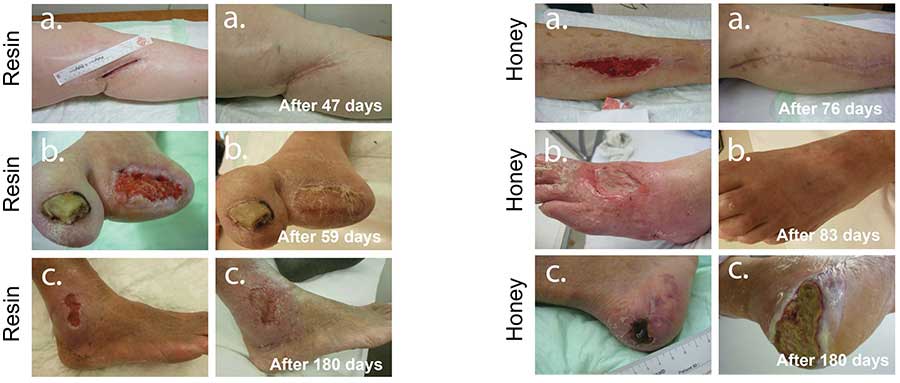Abilar used in the treatment of surgical wounds which were demonstrating delayed healing
Sipponen A, Kuokkanen O, Tiihonen R, Kauppinen H, Jokinen JJ. Natural coniferous resin salve used to treat complicated surgical wounds: pilot clinical trial on healing and costs. Published in International Journal of Dermatology 2012; 51:726-32.
This prospective, non-randomized clinical trial was designed to study healing rates, contributors to delayed wound healing, cost effectiveness and incidence of allergic reactions when Abilar 10% Resin Salve was used topically to treat complicated chronic surgical wounds.
The trial involved 23 consecutive patients whose wound healing after elective surgery was delayed. The patients were assigned to resin salve treatment within the control visit at the surgical outpatient department. All patients were ambulatory and primary care patients who carried out dressing changes themselves.
The primary outcome measures were the rate of wound healing and the number of days to complete wound healing. The end point was total healing (epithelialisation) of the wound. The wounds (mean size 29 x 12 x 4 mm) healed without any complications or allergy reactions in all cases in an average of 43+/-24 days, irrespective of whether the ulcer was infected or not. The wound healing measured as the closure of the wound length was 2 mm per day on an average.
“…observations of accelerated wound healing regardless of positive bacterial culture may be based on the resin’s capability to disinfect a wound by dispersing microbial biofilm from the wound cavity”.
Compliance with the resin salve treatment was exceptionally good.
The mean cost of Abilar treatment was 45+/-26 euros per patient and 1.2+/-0.5 euros per treatment day using price calculations based on Finnish prices. In the UK at an NHS cost of £8.00 per tube this would equate to £6.88 per patient or 16 pence per day.
“In conclusion, this study suggests that resin salve treatment is a clinically effective and cost-effective means of promoting the healing of chronic, complicated surgical wounds”.

- Male aged 55 years. – Lateral malleolus fracture
- Operated in July 2014. Plate removal due to a wound infection (Figure 1)
- Abilar 10% Resin Salve treatment was initiated in September 2014 and applied once a day
- After 35 days (Figure 2)
- The wound was completely healed after 109 days (Figure 3)

Severe ischaemic lower ulcer. Wound treatment was completed after peripheral arterial revascularisation by using the combination of Abilar 10% Resin Salve and Vacuum Assisted Closure (VAC).
A prospective, randomized, controlled clinical trial to compare resin salve and medical honey for effectiveness on wound healing after a peripheral vascular intervention
T. Auvinen(1), E. Haapakorva(2), A. Sipponen(3), K. Mäkinen(1), J. J. Jokinen(4)
(1)Department of Vascular Surgery, Heart Centre, Kuopio University Hospital, Finland, (2)University of Eastern Finland, (3)Department of Orthopedics and Traumatology, Päijät-Häme Central Hospital, Finland (4)Department of Thoracic and Vascular Surgery, Päijät-Häme Central Hospital, Finland
Background. The use of antimicrobial, nature-derived wound care products have rapidly increased in the Western world. Medical grade, honey-based, topical applications have been available for wound care for several years; but recently, resin-based therapeutic applications have also entered the wound care market in Europe. The treatment outcomes related to these two preparations have not been compared previously.
Methods. This prospective, randomized, controlled clinical trial included 40 patients that had undergone a peripheral vascular intervention, and required treatment for either a postoperatively-infected, acute surgical wound or an ischemic, chronic leg ulcer that persisted after revascularization. Patients were randomly allocated to receive either resin salve or medical honey treatment. Treatments were administered locally for up to six months.
Results. Nineteen (95%) patients in the resin group and 20 (100%) patients in the honey group completed the trial. At 6 months, complete wound healing was observed in 16 (84%) patients in the resin group and 11 (55%) patients in the honey group (P=.048). At 3 months [range; 69-116 days], the total number of positive bacterial cultures was reduced by 86% in the resin group and 92% in the honey group (P >.05). No hypersensitivity reaction related to either resin or honey was reported.
Conclusions. Resin salve and medical honey demonstrated similar clinical and antibacterial efficacy for the treatment of acutely infected surgical wounds and ischemic leg ulcers after revascularization. However, compared to medical honey, the resin salve may provide greater benefit in the late stages of wound healing; i.e., in the epithelialization phase.

Photographs of acute and chronic wounds at the initiation (left) and end (right) of treatment. (Left two columns) Wounds treated with resin salve; (Right two columns) wounds treated with medical honey. Labels indicate wound healing phase and treatment outcome, as follows: (a) acute and (b) chronic wounds with successful outcomes; (c) unsuccessful outcomes after 6-month treatments. Treatment times are indicated in the figures.


